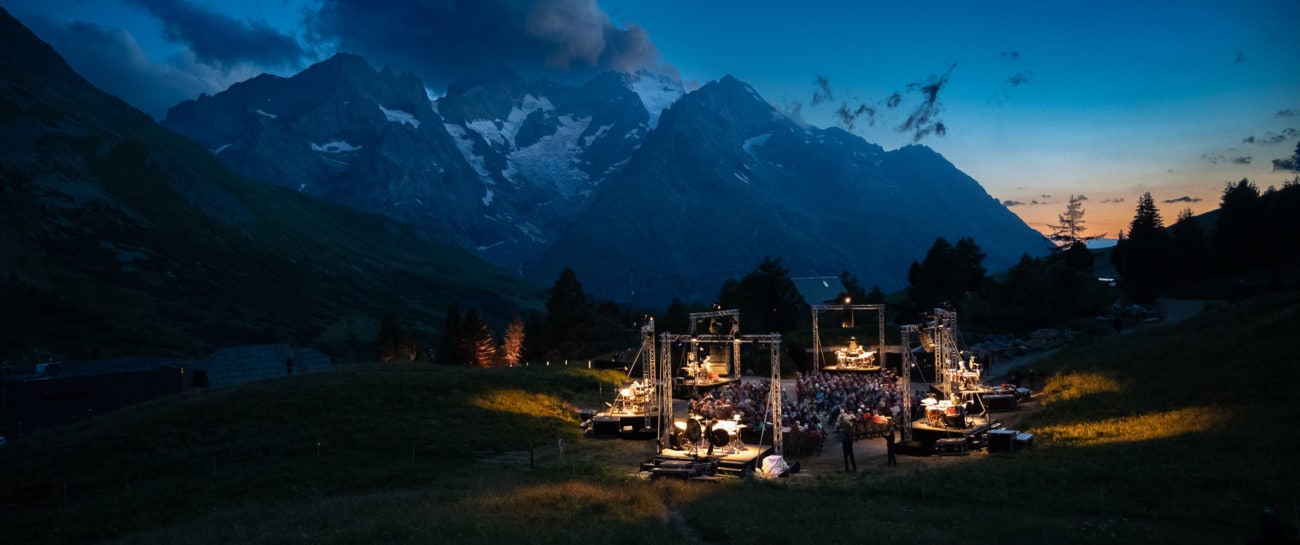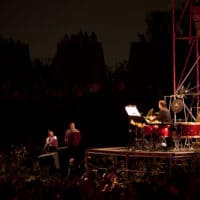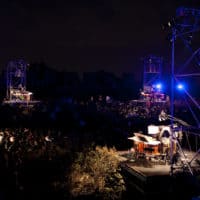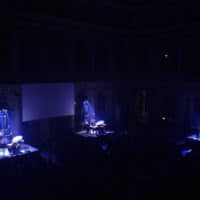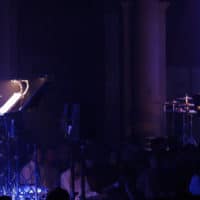Commissioned by French State and Percussions de Strasbourg
Creation : 16.03.1991 at Ars Musica Festival, Brussels, BEL
Music and conception : Gérard GRISEY
Scenography : Claudia DODERER, with K. DREISSIGACKER (architect) and
K. BOLLINGER (engineer)
Spatialization : Oton SCHNEIDER
Text : Jean-Pierre LUMINET
On stage : 6 percussionists, around the audience
Edition : Salabert
“When music succeeds in conjuring up time, it finds itself vested with a veritable shamanic power, that of connecting us to the forces that surround us.”
Gérard Grisey
“Le Noir de l’Étoile” by Gérard Grisey is one of the most impressive pieces by the French spectralist composer. In this work, pulsars – “clocks of spacetime” – form the tonal and poetic point of departure for a monumental space-piece for six percussionists, carried by rotation, periodicity, deceleration and acceleration.
« Le Noir de l’Etoile is dedicated to my son Raphaël with affection and to the Percussions de Strasbourg. And I would also like to point out: the unprecedented and irreplaceable aspect of the live transmission in the concert hall of these imperturbable cosmic clocks which have travelled across several light years…Their unexpected confrontation with music, which not only prepares their « entry » onto a musical and theatrical stage, but whose whole temporal organisation Is the product of their speed of rotation… Their integration into a spatialized form of music by the positioning of the six percussions and speakers around the audience… The staging and lighting of these extinguished stars using appropriate projection and lighting devices… The at once musical, visual, theatrical, but also festive and didactic character of a moving and exceptional event. »
Gérard Grisey
Introduction to LE NOIR DE L’ÉTOILE
“In 1967, a young astronomer detected in the heavens a rapidly varying radio signal, in the form of periodic impulses 1.3 seconds apart.
The discovery caused a sensation. The impulses were so regular that for a while they were taken to be signals coming from extraterrestrial civilisations. Then astrophysicists revealed a truth that was just as surprising: the signals were being emitted by a pulsar, the fantastic compact residue created by the supernova explosions that long ago disintegrated the massive stars.
Pulsars have a radius of only fifteen kilometres for a mass as great as that of the sun; they are made up of material so densely compressed that their atoms are crushed to form a solid mass of neutrons. A thimble of the material from one of these stars would weigh one hundred billion tonnes on Earth. Pulsars are giant magnetized spinning tops. Some of them rotate several tens of times per second, and their magnetic field is a thousand billion times bigger that the Earth’s. A pulsar’s magnetic lines of force channel the charged particles of the interstellar medium along its magnetic axis, which allows the emission of a beam of light that turns at the same time as the star, like a kind of cosmic lighthouse. With each rotation, the beam sweeps the Earth’s line of sight and astronomers record a light pulse. A part of this radiation is emitted within the field of radio waves. It can therefore be picked up using enormous telescopes. Radio telescopes are sophisticated radars designed to detect low intensity radio signals, such as those that come from far-away stars. They consist of large metal surfaces, smooth or in mesh form, upon which the radio waves are reflected. Antennae transform the waves into electrical signals. These signals can be amplified by the membrane of a loudspeaker. The human ear can then hear the murmuring of the pulsars.
In the electromagnetic tornado given out by a pulsar, the radio waves emitted represent only a whisper, and it is this that is picked up by the instruments. For an astronomer, it is like trying to understand the way a large machine in a factory works by listening merely to the few muffled noises that escape from it. The energy collected is infinitesimal… In 50 years of observations, all the energy gathered by all the radio telescopes in the world is less than that you need to turn a single page of your programme.
The first pulsar that you are going to hear has been recorded on magnetic tape for it can only be observed in the southern hemisphere. It is the Vela pulsar, the residue from the explosion of a supernova that primitive men could no doubt see in daylight 12 000 years ago. It spins at a rate of eleven revolutions per second.
The other pulsar is picked up by the Nançay radio astronomy station in Sologne. It is named 0329+54 (the figures are its galactic coordinates: 3hr29min right ascension and +54° declination). It spins at a rate of 1.4 revolutions per second. The supernova which created it exploded 5 million years ago and its radio impulses take 7 500 years to reach Earth. They are being picked up at this very moment in Nançay, and are transmitted directly to the concert hall.
Like great lighthouses in the heavens, pulsars will guide our musical navigation. Let us listen to these cosmic clocks marking out their seconds. We have an appointment with the guardians of time. It is a date with a loved one. Let us open the window and await the precise time.”
Jean-Pierre Luminet
Astrophysicist at the Meudon Observatory
Gérard GRISEY (1946 – 1998, FR)
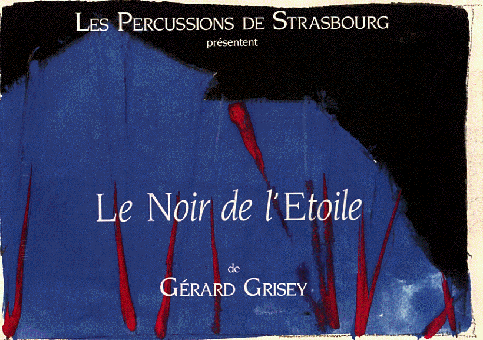
Pupil of Olivier Messiaen, Henri Dutilleux, György Ligeti, Karlheinz Stockhausen and Iannis Xenakis, Gérard Grisey was in residence at the Villa Medici from 1972 to 1974. The initiator with Tristan Murail and Hugues Dufourt of spectral music, he took part in the foundation of the ensemble L’Itinéraire (1973). He organised many composition seminars, taught at the University of Berkeley, then at the Paris Conservatory until his death. Constantly refining his scientific approach to the aural phenomenon, he explored its microphonic aspects, arriving at a stretched and ‘complexified’ temporality integrating contrasts, ruptures, and superposing different speeds, zones that are compressed or dilated to an extreme. His works include the cycle Les espaces acoustiques (1974-1985), Le temps et l’écume(1989), Le Noir de l’Etoile (1991), Vortex temporum (1996), Wolf Lieder (1997) and, his ultimate work, Quatre chants pour franchir le seuil (1998).
ON TOUR :
- 27.11.2022 Philharmonie du Luxembourg, Festival Rainy Days
- 29.07.2023 Festival Messiaen au Pays de la Meije

